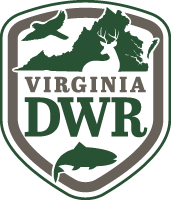By Carol A. Heiser/DWR
Refreshing rains in the early spring are a boon to amphibians that need standing water to breed and lay their eggs. Temporary bodies of water found in shallow depressions in woodlands and other low-lying areas during the spring are called vernal pools. These seasonal, ephemeral pools are critical aquatic habitats for many species of salamanders and frogs that require a safe place to reproduce without the presence of predatory fish. Each year, thousands of moist-skinned creatures emerge from underground hibernation and migrate to vernal pools to mate and pass on their genes to the next generation.

A vernal pool in hardwood forest habitat at Powhatan State Park. Photo by Carol Heiser
Extending out about 1,000 feet from the edge of a vernal pool is another important component, the associated terrestrial, forested habitat, where the extensive leaf layer provides a moist, protective medium that regulates water quality and also serves as a connecting corridor between pools in adjacent stands.
Vernal pools are a precious asset in the landscape, because they form a life-line for a whole suite of organisms that can only breed or live in water, known as “obligate” species. There are six species of obligate mole salamanders (all in the Ambystomatidae family), including the spotted salamander and the marbled salamander that occur in the Piedmont, and the eastern tiger salamander, which is found in southeastern Virginia. Two species of frogs, the wood frog and the eastern spadefoot, as well as several invertebrate species, such as fairy shrimp, are also vernal pool obligates.

A comparison of leopard frog eggs on left and wood frog eggs on right. Photo by Diane Girgente
Obligate species can be well-adapted to survive the changing conditions of vernal pool water levels and sediments. For example, the eggs of fairy shrimp that remain in the mud at the end of the spring season can survive several years of drying in summer and freezing in winter before they eventually hatch when conditions are more favorable.
Vernal pool amphibians have a very specialized, complex life history. The juveniles and adults spend most of the year in the terrestrial habitat in the leaf layer or underground, where they feed on insects, worms, and other invertebrates. When it’s time to breed, the adults move from the forest to the aquatic habitat, transferring the biomass, or energy, from the forest system into the pool system. The aquatic habitat then becomes host to the eggs and larvae, and once the larvae have grown into the juvenile stage, they complete their development and move away from the pool, back out into the terrestrial system. This annual flow of energy that gets transferred back and forth between the habitats is a vital ecological service, and it illustrates the biological interdependence that enables such specialized populations to persist over time.
You can easily find vernal pools on a woodland walk by looking for areas that have certain tell-tale characteristics, such as places where the ground-layer of leaves appear stained, gray, or covered with sediment, which is an indication of periodic standing water. Another sign is the presence of wetland plant species growing in the middle of a forest in what would otherwise be dry soil for most of the summer and fall months.

A spotted salamander adult. Photo by Diane Girgente
Virginia is home to more than 50 species of salamanders, and at this time of year, the spotted salamander (Ambystoma maculatum) is one of the first to leave evidence of their reproductive fervor. Salamanders are nocturnal, and during the day they spend their time concealed in the mud under woody brush or leafy debris, usually near the edge of a vernal pool. They become most active on nights of heavy rain, which is their cue to move out into the pool and breed. Spotted salamanders tend to return year after year to breed in the same pool they were born in.
Spotted salamander egg masses are highly variable in shape, size and color. They can be clear, or milky white, or an intermediate variation of both clear and white, depending on whether or not certain protein crystals are found in the outer layer of the gel.

Spotted salamander eggs in a clear mass. Photo by Carol Heiser

Spotted salamander larvae in a milky white mass. Photo by Carol Heiser

Spotted salamanders in early stage of development. Photo by Carol Heiser
It’s not uncommon to find spotted salamander egg masses that look green, too! This occurs when there are certain species of algae that are able to get through the membrane of the eggs, reproduce, and then photosynthesize, which gives the eggs their greenish tint. These single-celled algae are Oophila amblystomatis or salamander algae, whose genus name “oophila” means egg-loving. It’s thought that the algae’s symbiotic relationship with Ambystomid salamanders (and also wood frogs) imparts some survival advantages to the eggs.
The carbon dioxide and nitrogen waste that’s produced by the growing salamander or frog embryos is taken up by the algae. The algae then uses these byproducts for photosynthesis, and in the process releases oxygen and sugar, which are, in turn, beneficial to the embryos’ growth. It’s a win-win situation, as the embryos tend to grow better in association with the algae than without.

A green egg mass of spotted salamanders. Photo by Carol Heiser

Spotted salamanders appear green as they develop in association with symbiotic algae. Photo by Carol Heiser
After salamander embryos develop into larvae and the larvae leave the gelatinous mass, they live in their temporary, wet nursery for several months over the summer, looking much like their parents but breathing through feathery exterior gills. During their gradual metamorphosis or change into the adult form, they slowly lose their gills and develop lungs for terrestrial breathing.
Many Master Naturalists and other volunteers are actively monitoring the life within vernal pools at multiple sites around the state and are reporting their observations online at CitSci.org.

Anne Wright (at left), affiliate faculty Center for Environmental Studies at Virginia Commonwealth University Life Sciences, led a Vernal Pool Monitoring Training in late February for Master Naturalist volunteers. Photo by Carol Heiser
This type of citizen-science monitoring project provides invaluable observation data for researchers and also helps facilitate more interest in and stewardship of Virginia’s unique natural habitats.

Susan Watson, DWR Biologist, demonstrates sampling techniques during Vernal Pool Monitoring Training. Photo by Carol Heiser
Be sure to purchase a copy of the NEW A Guide to Salamanders of Virginia, hot-off-the-press from DWR. You can also learn about salamanders and other amphibians at www.virginiaherpetologicalsociety.com. Additional information and selected resources are available in a previous DWR article, Vernal Pools for Salamanders.
The Virginia Department of Motor Vehicles also offers the new “Wildlife Conservationist” license plate featuring an artist’s rendering of the official state salamander, the red salamander, on a background of blooming mountain laurel and moss.



